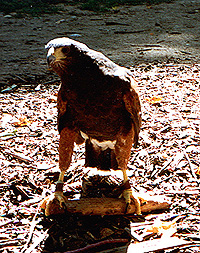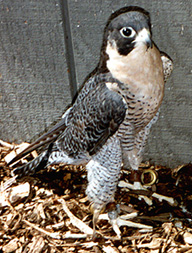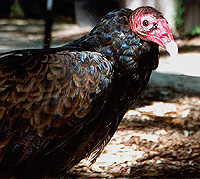What's the
difference between a hawk and a falcon? |

Sienna, adult female Harris' Hawk
|
Looking at the pictures, you'll notice that
the peregrine falcon (right pic) is much slimmer that the Harris' hawk(left pic). The
shape of the wings are also different. The falcon has pointed wing, while the hawk has a
more rounder shape. A hawk has shorter, fatter toes compared to those of a falcon, which
are longer and slimmer. There is a notch on the upper mandible in falcons and there is a
bony projection in the falcon's nostril. This prevents the air from rushing too rapidly
into the falcon's head when it stoops (dives). |

Willie, male Peregrine Falcon
|
What is that cloudy film that occasionally
sweeps a raptor's eyes?
That cloudy film is the nictitating membrane. It's
a third eyelid that protects the bird of prey at the moment of contact between itself and
its prey. Also it moistens and keeps the eyes moist.
Why raptors have the feet that they
do?
There are three main functions of a raptor's feet. The
first is that they are used to catch and kill their prey. Second, they are used as a
defense to ward off potential threats. When a raptor feels threatened, they'll either bite
with their sharp beak or strike at you with their taloned feet. Once a raptor grabs onto
you, its not going to let go...not a pleasant experience let me tell ya. And third they
are used by the raptor to stand and rest(perch) on branches, posts, and the like.
| Can birds
of prey smell? |

Lerch, adult male Turkey Vulture
|
Yes birds of prey can
smell, but their sense of smell is very weak. They rely more on their sense of sight.
There is an exception to this smell issue. Vultures (New and Old World) have extremely
good senses of smell. They rely on both sight and smell to locate their prey. These guys
feed on carrion (dead stuff) 99% of the time. New World vultures, like the turkey vulture
pictured on the left, have a hole thru their heads (open septum) that aids in their sense
of smell. Old World vultures, like Indian White Backed vultures don't have the open
septums. |
Why it is that a vultures'
legs and feet have a whitish tinge to them?
Their feet are whitish because they poop on them.
Seriously, birds have very little sweat glands and must devise other ways to expell excess
body heat. They'll pant and hold their wings out away from their bodies. Or they'll find a
shady spot to perch in. And vultures will poop on their legs. Vulture poop is white and
runny and as it evaporates on the legs it cools like when we, humans sweat.
Every now and then a bird of prey
will shake out all their feathers like a dog shaking water from their coat, why do you
say.
A raptor shakes out it's feathers (rousing) after a tense
situation of to re-align it's feathers after a preening session. When the weather is cold,
birds of prey rouse to trap air between their feathers and their body to form an
insulating area. That's why you seen birds all puffed up during the colder months.
|